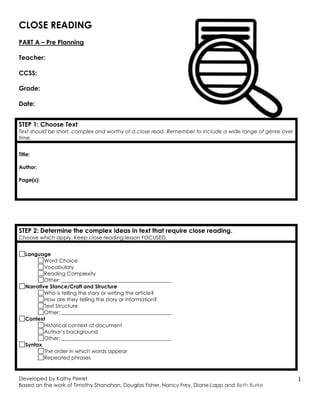
Close Reading Template
- 1. CLOSE READING PART A – Pre Planning Teacher: CCSS: Grade: Date: STEP 1: Choose Text Text should be short, complex and worthy of a close read. Remember to include a wide range of genre over time. Title: Author: Page(s): STEP 2: Determine the complex ideas in text that require close reading. Choose which apply. Keep close reading lesson FOCUSED. Language Word Choice Vocabulary Reading Complexity Other: __________________________________________ Narrative Stance/Craft and Structure Who is telling the story or writing the article? How are they telling the story or information? Text Structure Other: __________________________________________ Context Historical context of document Author’s background Other: __________________________________________ Syntax The order in which words appear Repeated phrases Developed by Kathy Perret 1 Based on the work of Timothy Shanahan, Douglas Fisher, Nancy Frey, Diane Lapp and Beth Burke
- 2. STEP 3: Generate text-dependent questions Select several high cognitive level questions that you may ask depending on students’ conversations with you and each other. Questions should require students to use the author’s words. Prompt to use text evidence. Use the progression of text-dependent questions as a guide to scaffold less. 1. 2. 3. 4. 5. 6. 7. Developed by Kathy Perret 2 Based on the work of Timothy Shanahan, Douglas Fisher, Nancy Frey, Diane Lapp and Beth Burke
- 3. PART B – Close Reading Lesson Establish Purpose The purpose of the first read is to determine what the text says. Establish a purpose. Limit front loading. Front loading should not take students away from text. Let’s read to find out … Remind Students: If you come to an unfamiliar word, look inside the word (structural analysis) for familiar portions and outside the word (contextual analysis) for clues to its meaning. List words in the margin that you use this technique with and other words that you are still stuck on. Encourage students to make notes to themselves about major events. Encourage students to circle or underline words, phrases, or sentences that are unclear to them. First Read: The first reading of a text should allow the reader to determine what a text says. Decide who will read the passage for the first time. Rule of thumb: primary grades teacher will do first read; upper grades students may do first read themselves. Teacher Read Student Read Notes (if needed) First Discussion: Partner Talk and Check Meaning Student dialogue about understanding of text. This can come in the form of a Think-Pair-Share. (Teacher listens and assesses what students have gleamed from the text.) Question posed should reflect purpose set. Have students use a language frame such as: I was amazed to learn … Developed by Kathy Perret 3 Based on the work of Timothy Shanahan, Douglas Fisher, Nancy Frey, Diane Lapp and Beth Burke
- 4. Second Discussion: Assessing for Understanding and Confusion. (Key ideas and Details) Invite students to share their amazing fact (or things learned) with the whole group. This will provide initial insight in to what portions of the text students understood. Ask students what words or phrases were unfamiliar or unclear to them and how they attempted to resolve them. Note students’ responses, as these will guide you regarding what should be modeled. Second Reading: The second reading should allow the reader to determine how a text works. (Craft and Structure) Teacher-Led Shared Reading and Think Aloud Notes on focus area: Third Discussion: Text-Dependent Questions The purposes of text-dependent questions are to prompt rereading, encouraging textual evidence to support answers, and deepen comprehension of analytic processes. This should not take the form of a worksheet! Use the text-dependent questions you developed in the pre-planning stage. Notes: Developed by Kathy Perret 4 Based on the work of Timothy Shanahan, Douglas Fisher, Nancy Frey, Diane Lapp and Beth Burke
- 5. Third Reading: Evaluate quality of text The third reading should allow the reader to evaluate the quality and value of the text (and to connect the text to other texts). (Integration of Knowledge and Ideas) Notes: Fourth Discussion: Strive for meaning The fourth discussion can take the form of a writing prompt or extended discussion with a focus on synthesizing ideas. Sample prompts: Why is this important for me to know? How will this help me? What message did you take away from reading the text? Why: Which passage of the text would you consider most significant or important? Why? Notes: Teacher Reflection (sample questions, not limited to): How did students respond? What was their level of understanding? What could be revised to improve the close reading? What are your next steps in this process? Do you need to provide additional support for small groups of students? Developed by Kathy Perret 5 Based on the work of Timothy Shanahan, Douglas Fisher, Nancy Frey, Diane Lapp and Beth Burke
